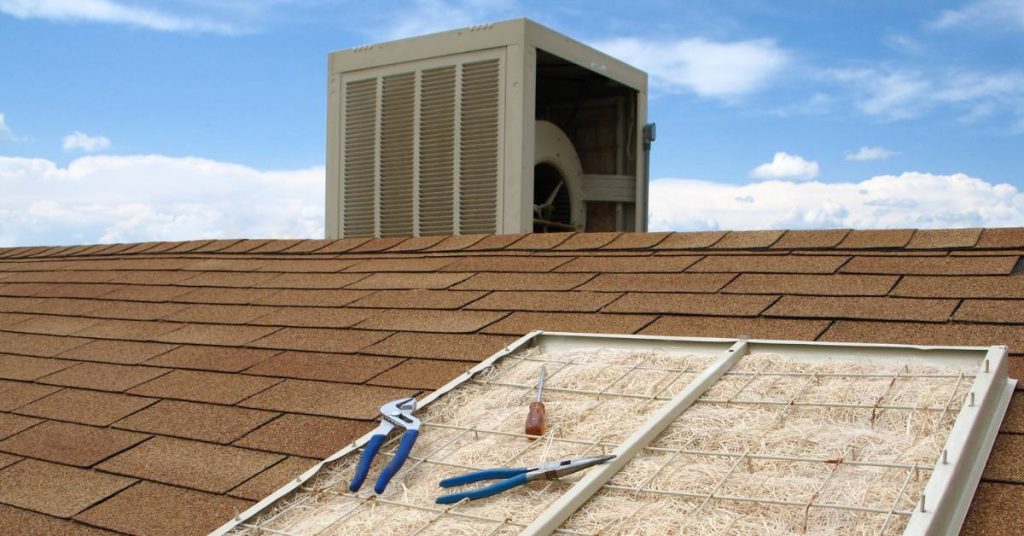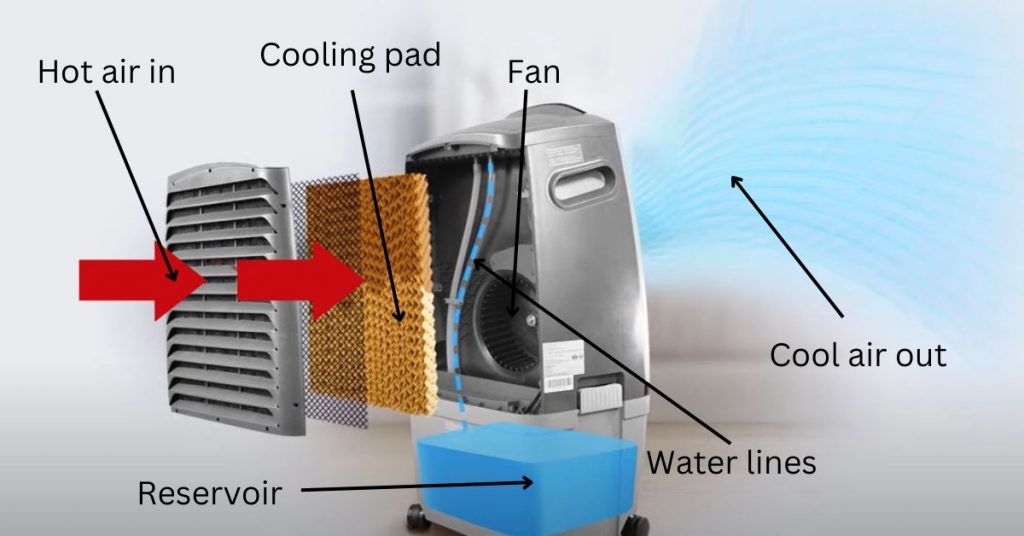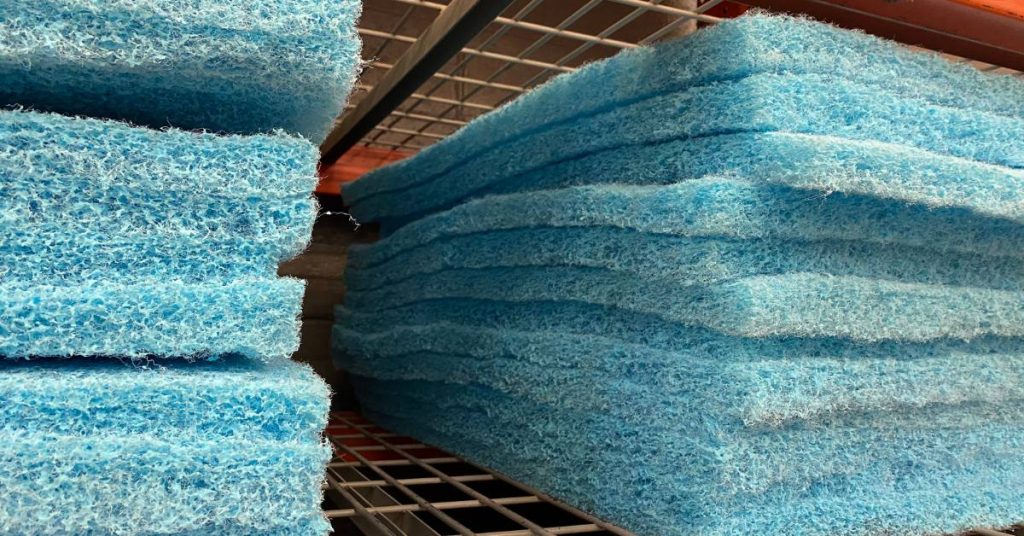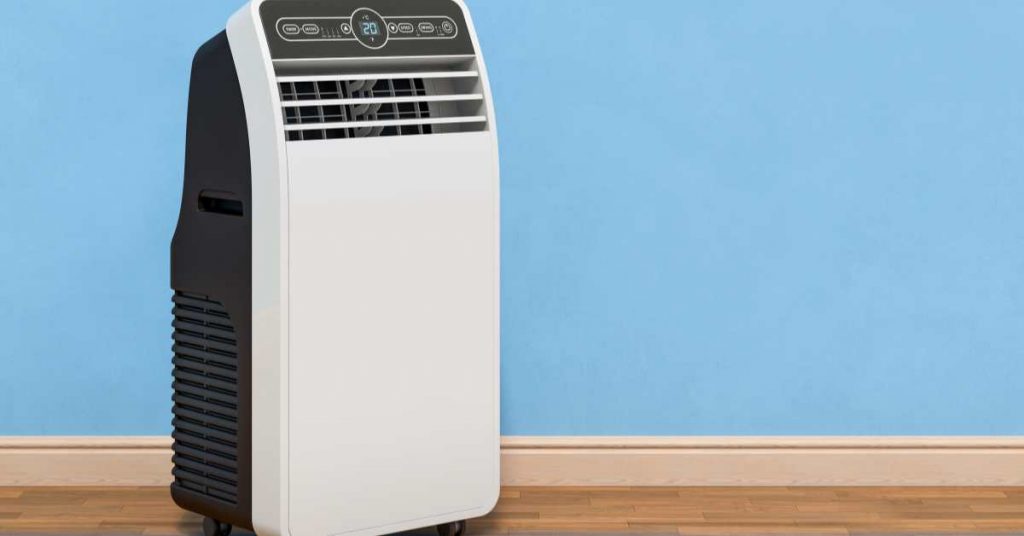
Swamp coolers, also known as evaporative coolers, are a type of air conditioning system that cools indoor spaces through the natural process of evaporation. Here’s a summary of how swamp coolers work:
- Evaporative Cooling: Swamp coolers operate based on the principle of evaporative cooling. They use a fan to draw warm outside air through water-saturated pads or media inside the unit.
- Moisture and Heat Exchange: As the warm air passes through the wet pads, the water in the pads evaporates into the air. This evaporation process absorbs heat energy from the incoming air, causing the air temperature to drop.
- Cool Air Delivery: The now-cooled air is then blown into the indoor space, effectively reducing the temperature and increasing the humidity level inside the room.
- Exhaust of Warm Air: As part of the process, warm, moisture-saturated air is exhausted outside, which helps maintain a continuous flow of cool air indoors.
- Maintenance of Water Supply: Swamp coolers require a constant supply of water to keep the pads wet. A water pump ensures a consistent flow of water over the cooling media.
- Control of Airflow and Speed: Users can control the cooling effect by adjusting the fan speed and the amount of air drawn through the wet pads.
- Effective in Dry Climates: Swamp coolers are most effective in dry and arid climates with low humidity levels. In humid conditions, their cooling efficiency decreases.
- Eco-Friendly and Energy-Efficient: Swamp coolers are considered environmentally friendly because they use less electricity and do not rely on refrigerants, making them energy-efficient and cost-effective.
- Maintenance: Regular maintenance is essential to prevent mineral buildup in the cooling media and ensure the system operates efficiently. Maintenance tasks include cleaning the pads, checking the water supply, and ensuring proper ventilation.
The main difference between swamp coolers and air conditioners is that swamp coolers cool air using water while ACs use a chemical (refrigerant). Also, air conditioners will always dehumidify the room while swamp coolers increase the relative humidity of the air.
Swamp coolers are way cheaper to run than air conditioners. Not only are they more energy-efficient (sometimes up to 10 times) but they are also easier and cheaper to maintain seeing that they have fewer components than air conditioners.
How Swamp Coolers Work
If you think about it, there is no cooling without evaporation. For evaporation to occur, a liquid has to absorb heat from the surrounding air, thereby cooling it. I reckon that is why swamp coolers are also known as evaporative coolers.
It is actually also how air conditioners work. The refrigerant enters the evaporator coil (inside the house) as a liquid. In order to cool the indoor air, the refrigerant has to evaporate (after absorbing heat from the air), and that is why a good refrigerant will always have a high latent heat of vaporization and low boing point.
Just like with air conditioners, there are ducted and non-ducted swamp coolers. Ducted swamp coolers are ideal when you want to cool a house with several rooms and are generally big in size.
Non-ducted swamp coolers also known as portable swamp coolers are ideally used to cool a single room. For the sake of this explanation I will use ducted swamp coolers then come back to portable swamp coolers later.

Swamp coolers are made up of the following parts:
- Cooling pads
- Water pump
- Water reservoir
- Fan
- Float
- Water distribution line
This is how a swamp cooler works from the time you turn it on:
1. Water Fills the Reservoir
Since the swamp cooler is connected to the water supply in your house (and we need water to cool the house), the first thing that happens is that the water supply line fills the reservoir with water.
The reservoir basically is a small tank located at the bottom of the unit. To prevent it from overflowing, it is equipped with a float that works just like a toilet float.
When the water level in the reservoir is sufficient, the float turns off the water supply. The float also opens up the water valve when the water level in the reservoir is low.
2. The Pump Moistens the Cooling Pads
The cooling pads are made from an absorbent material and are installed vertically across the length of the unit. Apart from cooling the air, they also clean it by removing impurities and that is why they need to be replaced regularly.

The pump is responsible for drawing water from the reservoir and pouring it over the cooling pads. This is the water that absorbs heat from the air.
The unit can be adjusted so that the pump pumps more water for better cooling when you feel like the unit is not cooling sufficiently. That is done by turning the swamp cooler’s switch to “pump”.
3. Warm Air is Drawn In
When the cooling pads have been sufficiently moistened, the fan/blower kicks in and starts pulling warm air from the room. The warm air is forced through the cooling pad where it is not only cooled but cleaned.
Cooling happens when the water in the cooling pad absorbs heat from the air and evaporates. As the water evaporates, it takes with it heat from the indoor air.
Because of the constant evaporation of water, the reservoir will need to keep drawing more water from the supply lines. Filling of the water reservoir is also triggered by the float, when the water level drops below the set mark.
4. Cooled Air is Forced Out through the Ducts
After the indoor air has been cooled, the fan picks it up and forces it out of the unit through the house’s ductwork. And basically that is how swamp coolers work.
While using a swamp cooler, it is important to slightly open a window or door. That helps to create the required airflow for the cooling pads so that the they can have the evaporative effect needed to cool the air. Ventilation is improved as well.
Also, since swamp coolers release warm and humid air in the house (due to the evaporation process), opening the window allows the air to exit and less humid air to flow in, thereby creating a good air balance.
Two-stage Swamp Coolers
Modern swamp coolers, also known as a 2-stage swamp coolers are more effective than single-stage swamp coolers while at the same time releasing less humidity (moisture) in the room.
As I have mentioned, swamp coolers struggle to cool the air when temperature exceeds 100 degrees. That is where 2-stage swamp/evaporative coolers come in.
How is 2-stage swamp coolers different from single-stage swamp coolers? Well, single-stage swamp coolers use direct evaporative cooling process while 2-stage uses a direct and an indirect cooling process.

The first step is the indirect cooling process. Warm air from the house is passed through an air water heat exchanger. Here, cold water recirculation is used to preheat the ambient air coming from the room.
In this first stage, no moisture is added to the air, allowing its temperature to drop relative to that outside air. The cold water absorbs heat from the air and takes it away.
In the second stage, the direct evaporative cooling process is employed. As a result, the air will be cooled to a lower level while at the same time not increasing indoor humidity by much.
Should You Open a Window When with a Swamp Cooler?
It is possible to use a swamp cooler as a whole-house fan. That is because swamp cooler comes with a “vent only” option which you can switch to when the temperatures are not too high.
When you switch your swamp cooler to the “vent only” settings, the water pump does not run, which means that the cooling pads are not moistened. The fan will however keep running.
The effect of this is that the air is not humidified, but instead the unit will simply work like a whole-house fan.
By knowing which windows to open in the house, you can control the swamp cooler’s air movements. Opening the windows on the leeward side of the house (the side that is not directly exposed to the wind) will help.
Just remember that opening the windows too wide will allow excess hot air in the house. You need to experiment the gap to leave opened for a few days until you get it right. Bear in mind that failing to open the windows will allow humidity to buildup indoors.
If for one way or another opening windows is inconvenient for you, consider installing up-ducts through the ceiling. Attic installation is key when swamp coolers are installed with up-ducts since the coolers will exhaust warm air into the attic.
Swamp Coolers vs Ventless Portable Air Conditioner

Is there a difference between swamp coolers and ventless portable air conditioners? Or are they one and the same thing?
The truth of the matter is that there is no such thing as ventless portable air conditioners. Real portable air conditioners have to be vented since the heat absorbed by the refrigerant has to be released to the outdoors, otherwise it would be circulated back to the room.
Ventless portable air conditioners are in essence portable swamp coolers. They are commonly referred as such since they look exactly like portable air conditioners but without a vent.
Just like portable air conditioners, portable swamp pumps are not connected to the ductwork and are used to cool rooms and not the whole house. Since they are not vented, portable swamp coolers are easy to move around.
Unlike ducted swamp coolers, portable swamp coolers don’t need to be connected to the water supply in the house. The water is manually added to the reservoir (they let you know when water level is low) and all you have to do is plug them to an electric outlet.
Portable swamp coolers can be used indoors and outdoors. If you therefore have an outdoor space that you would like to cool then a portable swamp cooler would be a great option.
Although swamp coolers are designed for use in dry climates where humidity is low, they can be used outdoors everywhere. Folks in in humid areas can therefore enjoy this coolers outdoors.
Who Should Buy a Swamp Cooler and Who Shouldn’t?
Swamp coolers are designed to be used in hot and dry areas where humidity is not a concern. In the United States, that would be the South Western states Like Arizona, Nevada, Utah and New Mexico.
As they cool the air, swamp coolers have to evaporate the water in the cooling pads. The water turns into vapor and is released in the house. If the relative humidity in your area is low, that will not be a problem.
However, if you live in an already humid area, you don’t need more humidity in the air. High humidity is known to make the air feel hotter than it actually is.
The reason for that is because when the relative humidity is high, sweat cannot evaporate from our bodies and as such we cannot cool of. As a result, our bodies feel sticky and uncomfortable when humidity is high.
For Context, the average relative humidity in Florida is 74.5% while that of Arizona is 38.5%. Since the ideal indoor humidity is around 30-50%, a swamp cooler can add humidity inside a house in Arizona without any effects but adding more humidity in a house in Florida will be punishing for the people in the house.
As I said however, portable swamp coolers can be enjoyed outdoors everywhere, but as you can tell they will be enjoyed more in dryer areas more than humid ones.
Swamp Coolers vs Air Conditioners
Air Conditioners cool a room/house by absorbing heat using a refrigerant like Freon. The refrigerant flows through a closed-looped system consisting of an evaporator coil, condenser coil, compressor and expansion valve.

A good refrigerant will have a low boiling point and high latent heat of vaporization. Inside the closed loop, the refrigerant will turn from liquid to gas (absorbing heat from the air) and from gas to liquid (releasing the heat to the outdoors).
As a result, air conditioners will always have an indoor and outside unit. The indoor unit (the evaporator coil) is where the refrigerant absorbs heat from the indoor air and the outside unit (the condenser coil and compressor) is where the heat will be released to the outdoors.
And that is the reason why portable air conditioners are always vented. The exhaust vent takes the heat away from the condenser coil to the outside.
In contrast, swamp pumps don’t have an outside unit. All the units are housed together in one piece. These units may be a good option for folks who don’t like the “ugly” condenser unit outside their house.
Apart from cooling the indoor air, air conditioners also reduce the relative humidity in the house. When the warm and humid air makes contact with the cold evaporator coil, the moisture in the air condenses and is drained outside.
An air conditioner can remove anywhere between 5 and 20 gallons of water from the indoor air in day depending on its sizing and relative humidity.
Swamp coolers do not reduce relative humidity of the indoor air. In fact, they increase it. For that reason, air conditioners can be installed anywhere but swamp coolers are only good for hot and less humid areas.
Ducted swamp coolers cost half (or even less) to install compared to ducted/central air conditioners. They also consume ¼ of the energy consumed by central air conditioners but may require frequent (but cheap) maintenance.
It is also good to mention that swamp coolers don’t cool a room as much as air conditioners, especially when outside temperatures are quite high. ACs will cool your house to the desire level despite the outside temperature levels.
Here’s a table outlining the key differences between swamp coolers (evaporative coolers) and air conditioners:
| Aspect | Swamp Coolers (Evaporative Coolers) | Air Conditioners (Traditional) |
|---|---|---|
| Cooling Mechanism | Evaporative cooling through water-saturated pads | Refrigeration cycle that removes heat |
| Energy Efficiency | Highly energy-efficient, consume less electricity | Typically consume more electricity |
| Environmental Impact | Environmentally friendly, use water as the cooling medium | Use refrigerants, some of which may have environmental concerns |
| Humidification | Add moisture to the air, increasing indoor humidity | Naturally dehumidify the air as they cool |
| Cooling Effectiveness | Effective in dry, arid climates with low humidity | Effective in a wide range of climates, including high humidity |
| Cooling Precision | Cooling is influenced by outdoor humidity levels | Provides precise temperature and humidity control |
| Maintenance | Requires regular cleaning and pad replacement | Maintenance typically includes filter replacement and refrigerant checks |
| Cooling Cost | Cost-effective operation with lower energy bills | Higher operating costs, especially in warm climates |
| Suitable Climates | Ideal for dry, low-humidity regions | Suitable for a variety of climates |
| Indoor Air Quality | Increases indoor humidity, which can be beneficial in dry climates | Naturally lowers indoor humidity, reducing moisture levels |
| Environmental Considerations | Water usage and maintenance are primary concerns | Refrigerant management and energy consumption are key considerations |
Pros and Cons of Swamp Coolers
I am sure I have outlined the advantages and disadvantages of swamp coolers throughout this post but I will briefly go through them again. This should also help you know if swamp coolers are something you should consider or you are better off sticking with air conditioners.
Pros
The following are the benefits of swamp coolers:
- Low upfront cost – Swamp coolers offer an energy-efficient way of cooling a house since they are way cheaper compared to air conditioners. Their installation cost is also cheaper compared to central air conditioners.
- Energy-efficient – Since swamp coolers use the natural evaporation process to cool a room, they consume less energy (more than 5 times over ACs) making them cheap to run.
- No need for outside unit – Most people perceive the outside AC unit to be ugly so if you install a swamp cooler that is not something you will having to see everyday.
- More sustainable – Air conditioners leak refrigerants which deplete the ozone layer resulting in global warming. Swamp coolers do not release any harmful gases.
- Can be used indoors and outdoors – I like the fact that portable swamp coolers can be used both indoors and outdoors because of their portability.
- Increase humidity – Low humidity is just as bad as high humidity if not worse. In areas with low humidity, swamp coolers will help you to breathe better and hydrate your skin.
- Easy and cheap maintenance – maintaining air conditioners is expensive as you have to recharge the system with the refrigerant and replace some parts which are not cheap. Swamp coolers have fewer and cheaper parts.
Cons
The following are the disadvantages of swamp coolers:
- Not ideal for humid areas – swamp coolers cannot be used in humid areas since they increase the relative humidity, which makes the air muggy and promotes mold growth.
- Low output – Swamp coolers don’t cool the air as well as air conditioners especially when the temperature exceeds 100 degrees.
- They need through cleaning – Swamp coolers need be thoroughly and regularly cleaned to make sure they work well and also prevent growth of mold. The pads also need regular changing and are not cheap.
- They need constant water supply – Swamp coolers need water to run which can be a challenge if you don’t have constant water supply.
- Some units are slow to cool – If the unit had been turned off, it takes some time to properly cool the air.
Wrap Up
And basically that is all in as far as swamp coolers are concerned. I hope that by now you know what swamp coolers are, how they work, where they can be used, their pros and cons as well as how different they are from air conditioners.
